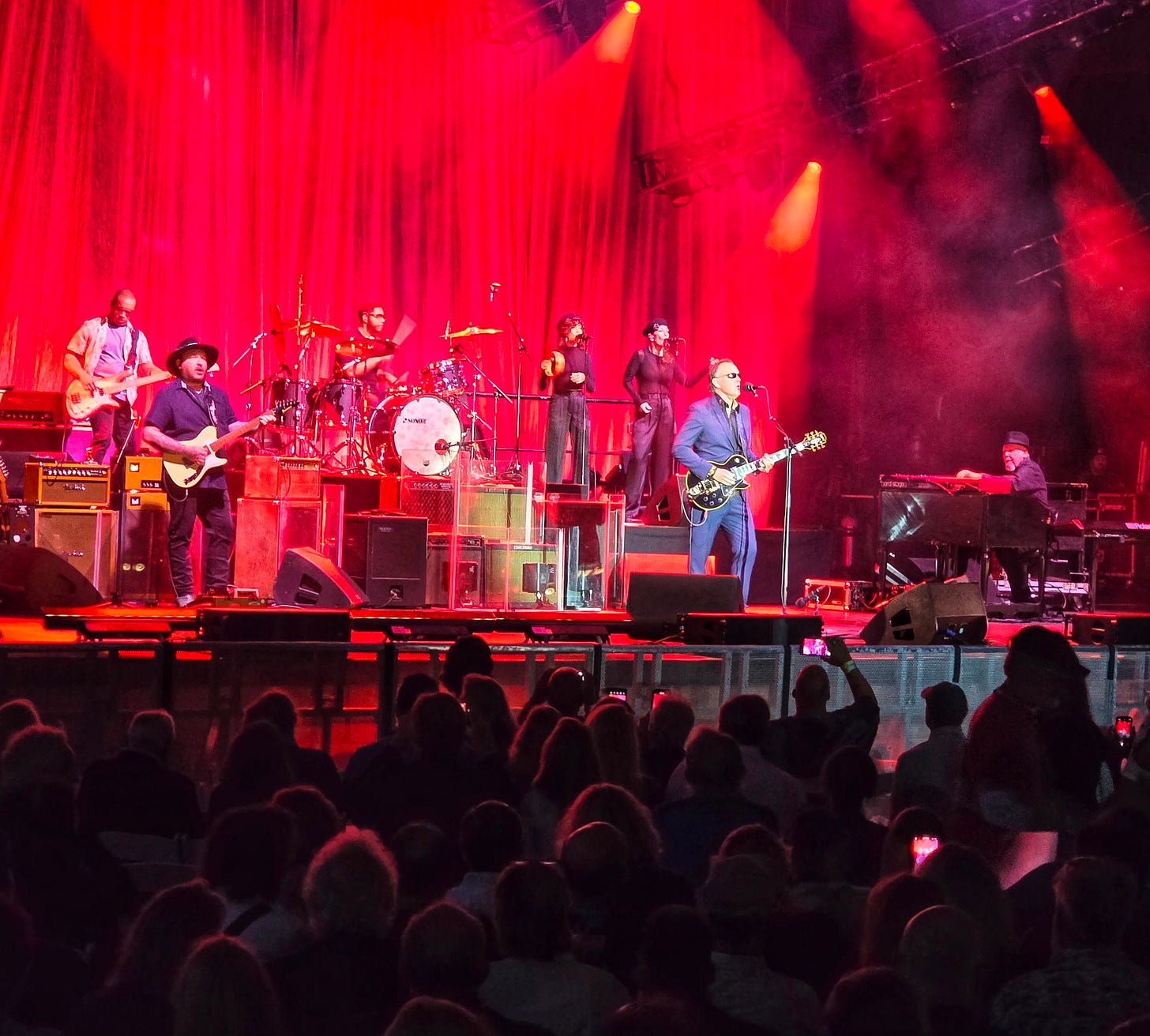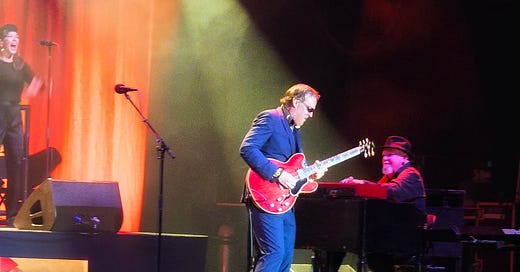“The Man In The Suit” Keeping The Blues Alive
Why my first Joe Bonamassa concert won’t be my last
On a balmy March evening, about 4,000 blues fans piled into the St. Augustine Amphitheatre in Northeast Florida. My father and I were two of them, and as we found our seats early, we anticipated crossing another artist off our live show bucket list.
The show was all but sold out because singer-guitarist Joe Bonamassa sold us on his barn-burner brand of blues-rock long ago.
In baseball, players have individual walk-up songs that play as they take the field. In the sport of live music, musicians have walk-out songs as they take the stage. Though it wasn’t a record-breaking crowd of 50,000 that Babe Ruth once drew, Bonamassa, one of our epoch’s preeminent blues players, does draw plenty of attention.
As his walk-out song fired up, and a horn section blared and overdubbed vocal tracks roared, so did the amphitheater. I quickly gave up attempts to figure out Bonamassa’s walk-out song as the crowd cheered more and more with each new band member taking the stage. When the road warrior appeared for the first time, I quickly realized I could calm my fears about the blues being a dying genre.
When it comes to Bonamassa, the blues are clearly alive and well.
The six-string picker could play larger arenas. In an interview with Guitar Player magazine, it was suggested that he could possibly sell out “the Garden,” or Madison Square Garden in New York. However, Bonamassa was quick to dismiss it as an option. Not because he thought tickets wouldn’t sell, but because he really enjoys the intimacy theater-style venues offer.
“I just like theaters. I can interact with the crowd better in that kind of space. And listen, you can make plenty of money in a theater. I want to have a good experience, and I want my fans to feel the same way. Arenas can get cavernous and the sound gets wonky. You have to spend a lot of money to try to recreate the vibe of a theater in an arena.”
An intimate venue means the performance has to be all about the music. In a no-frills situation, one can’t fake their way through the art of the live show with props, pyrotechnics, and other tricks of the trade.
Bonamassa puts on a no-frills show because he’s too good to need the grace of slight-of-hand distraction.
Sharp-Dressed Man
Like every other Bonamassa show, the singer-songwriter stepped into the limelight in a suit. Though I imagine the one he wore in St. Augustine was a bit more pricey than the first suit he wore on stage at the suggestion of his longstanding producer, Kevin Shirley: an $89 activewear ensemble from TJ Maxx.
His classic pair of shades rounded out his signature look. The sunglasses aren’t worn in an effort to score more cool points with the crowd. He’s already got plenty from us. His dark shades act as a barrier from the 2,000 watt spotlights beaming down on him.
For two hours straight, Bonamassa played and didn’t take a break.
He undoubtedly draws an older crowd. I think I was the youngest one there, an experience I relished a bit since it happens less and less. He once joked. “That's where the Black Keys and Jack White have succeeded and I've failed: They've actually convinced college kids that they're listening to hip music - but it's just blues twisted a new way - while I'm playing for the college kid's parents.”
Though we spent some time chatting with our row mates, once the concert started, not another word was said until the closing number. Though this was a crowd who didn’t grow up in the age of instant gratification, I think even the younger Tik Tok crowds with three second attention spans could increase their focus time to at least six seconds with Joe playing.
A Powerhouse Band

His rendition of “Twenty-Four Hour Blues” was especially captivating. And while many electric guitarists fall into the trap of thinking impressive playing means fitting as many notes into one solo section as possible, Bonamassa is clearly an experienced romantic.
There’s plenty of guitar-heavy music that doesn’t interest me due to the haphazard multitude of riffs I just mentioned. But Bonamassa does something different. Even when he’s not singing, his guitar is.
His backup singers, vocalists Jade MacRae and Danni D’Andrea, provide such a soulful element to the band’s blues and rock stylings that their talents become essential to the show rather than complementary. Thankfully, towards the end of the performance, Bonamassa left the vocalists plenty of room to showcase their abilities and for a second, I worried that the instruments in the planes flying overhead might be affected by the sheer power and indomitability of the instruments on the ground.
Bonamassa’s keyboard player, Reese Wynans, understandably received a huge round of applause from the audience. Concert-goers were already familiar with his work with one of Joe’s influences, Stevie Ray Vaughan. Though Bonamassa brings plenty of attitude to the stage, he remains a modest voice when talking about his bandmates. In a 2023 Billboard interview, he referred to Wynans as a “living legend,” and said of the group of musicians backing him on stage, “[They’re] better than me — all of them…”
Simplicity and Anglophilia
While the bluesman was influenced by Vaughan, a Texas native, he heavily gravitated towards English blues players like the late, great Jeff Beck, and Eric Clapton.
“Eric Clapton and Jeff Beck made me an Anglophile. I listened to English and Irish artists as a kid, and they were way louder, heavier, and faster than the traditional blues that I was listening to.”
At any given moment, Bonamassa has several different vintage guitar options off-stage to choose from. But, carrying on the torch of his early influences, the Gibson Les Paul remains a favorite.
In an interview with Total Guitar featured on Guitar World, he shared, “I play Les Paul Standards for the simplicity. And my heroes played Les Pauls, too. Pretty much all of the English guitar legends of the 1960s – everyone from Eric Clapton to Jeff Beck, Jimmy Page to Peter Green and later influences like Gary Moore – that’s what they were holding.”
He also once appropriately compared the Les Paul to one of the world’s top luxury cars.
“There's great cars, and then there's Aston Martins. Same thing for the 1959 Les Paul - it's an authentic piece of art that can never truly be replicated, and its mysteries are special.”
Human, All Too Human
Despite my worries, the planes’ instruments overhead remained sound. So did Bonamassa’s.
Our exit left us ranking the performance among one of our favorites, with only Buddy Guy and Kenny Wayne Shepherd, two talented blues giants, keeping their competitive edge for first place. It’s hard to top an 80-year old Guy walking through the crowd as he tears into a guitar solo while performing his top hit, “Feels Like Rain.” Shepherd opened for him that day with super group The Rides headed up by a hilariously crotchety Stephen Stills (I’ll never forget Stills’ mid-show rant about the rampant use of cell phones at concerts).
These days, with recorded music costing fractions of pennies for consumers, the art of the live show, something that is irreplicable for each fan, is as important as ever. And Bonamassa is a master of it. That makes sense, given the fact that he’s kept a busy performance schedule since his first live appearance with B.B. King back when he was just 12 years old.
“The fact that I tour religiously in the spring, religiously in the fall, and do 125 shows - you can set your watch to that.”
For Bonamassa, who has famously grimaced on more than one occasion when asked if he ever thinks about penning that ever-elusive hit song, it’s always been about the music—in particular, the blues. Why? In my opinion, those who gravitate towards the blues probably also operate under the love language of physical touch. The blues feel less ethereal than other genres like pop or jazz. The blues are something you can touch because the blues are probably something you’ve had. And if you've ever had it, I mean really had the blues, the music of the genre becomes something tangible, something palpable, something every single sense other than sound can experience too. And when you reach that point, the blues becomes a radically concrete, radically grounded, radically reality-oriented medium like no other. And that is precisely what fills it with an essence of divinity. To me, the blues, like the title of Nietzsche's book states, is Human, All Too human.
For Bonamassa, he relates the blues to one of our everyday necessities, nourishment.
“The blues, the way it's interpreted, is always a product of your environment, and so it's almost like food. You know, it's like you use the ingredients, and you use your life experiences that you have.”
Many of Joe’s fans attend his performances regularly. When my father and I sat down before the show, the gentleman next to me asked if we’d seen him live before. After I told him it was our first time, he replied, “Well, get ready, because you’re in for a treat.”
I’ve got a killer sweet tooth. We’ll be back for seconds.





Your dad is still talking about how amazing that concert was. And of course, hitting YouTube to ramp up the volume on Joe's videos, lol. So glad you both enjoyed the Bonamassa concert. And so glad you went with him because although I do like his music, you two are the blues fans because you both play the blues (and you sing them spectacularly) so well. I still love your 'Burn Out This Flame' recording.
"Pretty much all of the English guitar legends of the 1960s – everyone from Eric Clapton to Jeff Beck, Jimmy Page to Peter Green and later influences like Gary Moore – that’s what they were holding.”
Jeff Beck playing a Fender here:
https://www.youtube.com/watch?v=5e_LuhIu288
Also Clapton played one more often than not, too.
(Not there's anything wrong with the Les Paul! Good article)